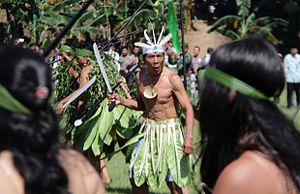Enggano people

An Enggano man performing a war dance.
|
|
| Total population | |
|---|---|
| 1,500 (2000) | |
| Regions with significant populations | |
|
|
|
| Languages | |
| Enggano language, Indonesian language | |
| Religion | |
| Christianity (Roman Catholicism), Islam (Sunni), Folk religion (animism, totemism, ancestral worship) | |
| Related ethnic groups | |
| Batak, Nias people |
Enggano people are an isolated group of people in Indonesia that inhabits Enggano Island near the southwest off the coast of Sumatra Island. The population of the people are numbered at approximately 1,000 people as of 1999 and is constantly decreasing.
The Enggano language that the people spoke are an early Northwest Sumatran languages of the Austronesian languages.
The Enggano people are one of the oldest tribes of Sumatra. Ethnically, they are closely related to the indigenous tribes of Java and Sumatra, from where migration flows directly to Enggano Island. The most anthropology related people of the Enggano people are the Batak and Nias people and distantly related to the Lampung people (Abung and Pepaduan).
The social organization of the Enggano people largely resembles the social model of the Nias people and now retains the paternal features of the family. Rural communities are of a neighbor-large-family type. The main social unit is marga or merga (surname), an expanded genus whose members are descended from a common male ancestor and retain its name, usually legendary. Outsiders from other margas that came later also live in the settlement. Within the marga there are also saompu, large patriarchal families, where each of them occupies one house. A large family has land and is governed by its elder. Communities are governed by elective village councils.
They strictly observe exogamous traditions, where men and children of the village belong to the marga of their forefathers, while wives are taken from other marga. One cannot marry into the same marga or to a woman from the marga from which the groom's sister marries. A polygamy is acceptable, where a man can have as many wives as long as he can afford the marriage dowry. Marriage settlement is patrilocal. A married woman passes into the family of her husband, takes on his surname, preserving it as her family name. The groom's father allocates a piece of land to his son, the child that receives the family name of his father.
...
Wikipedia
